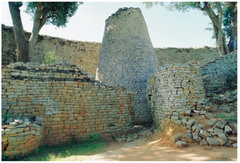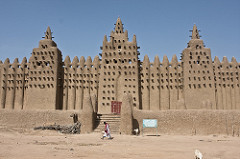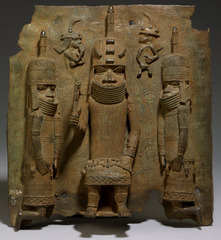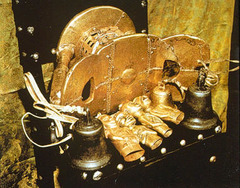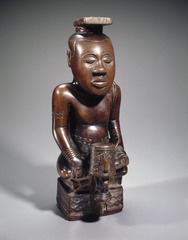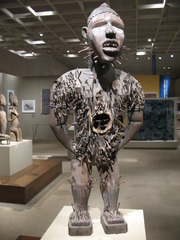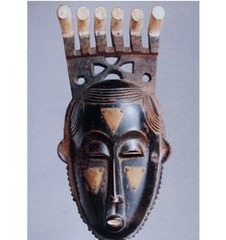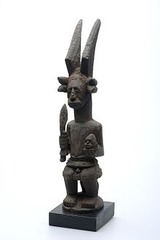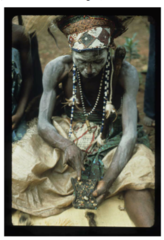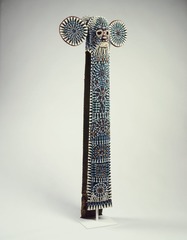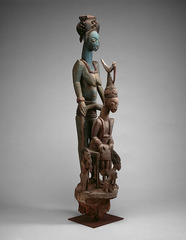Name: Conical Tower and Circular Wall of Great Zimbabwe
Date: 1000 CE
Medium: Coursed granite blocks
Location: Southeastern Zimbabwe
Artist: Shona Peoples
Form: Great enclosure with multiple areas, brick huts, smooth walls - no mortar was used,
Function: Religious center, wall to keep in cattle, palatial complex
Content: Great wall and large tower (tower is religious center), chevron pattern near top
Context: In between gold rich plateau and Indian Ocean ports
Name: The Great Mosque of Djenne, Mali
Date: 1000 CE
Medium: Adobe mud brick
Location: Djenne, Mali
Artist: Mali Peoples
Form: Largest mud brick building in the world,
Function: Moque for people to pray in (separate hall for women)
Content: The things sticking out of the wall act as a type of scalffholding
Context: Influenced by Islam and the local Sudano-Sahelian style, also an annual festival was created out of necessity of replastering the mud brick once a year, has been rebuilt multiple times
Name: Wall Plaque of Oba's Palace
Date: 1600 CE
Medium: Cast brass and ivory
Location: Benin City, Nigeria (South/Mid Western Nigeria)
Artist: Edo People
Form: Hierarchy of scale, relief sculpture
Function: To display the king's power
Content: King Oba standing in the middle with attendants kneeling beside him with two tiny Portuguese traders in the back, Portuguese are non human looking
Context: It is the people's obligation to assist the king with whatever he needs, whenever he needs it
Name: Sika dwa kofi (The Golden Stool)
Date: 1700 CE
Medium: Wood covered with gold and cast-gold attachments
Location: Southern Central Ghana
Artist: Ashanti people
Form: Size of a piano bench, but shorter; bells on the side are designed to warn the king of approaching danger
Function: Symbolically represents the spirit of the Ashanti nation, represents royal family and succession
Content: Shaped like a stool
Context: The Ashanti Uprising/The Golden Stool War occurred in 1900 because a British governor demanded possession of the stool, the stool is so valuable that the location of it is only known by the king, queen, and highly trusted advisors (replicas are usually used in ceremonies)
Name: Ndop (portrait figure) of King Mishe miShyaang maMbul
Date: 1700 CE
Medium: Wood
Location: Democratic Republic of the Congo
Artist: Kuba peoples
Form: Idealized characteristics; head is 1/3 size of body = value of intelligence; various ornaments and accessories
Function: To hold the spirit of the king; idol = object that links to the ruler
Content: Ndop - portrait figure that usually portrays leaders, expressionless and calm, rounded counters, defined lips and collarbones,
Context: Belief that the Ndop contains the spirit of the king and absorbs the king's life force when he dies; peaceful, spiritual figure that is considered a concrete piece of their history
Name: Power Figure (Nkisi n'tondi)
Date: Late 1800s CE
Medium: Wood
Location: Democratic Republic of the Congo
Artist: Kongo peoples
Form: Metal and ceramic insertions; painted eyes; hollow stomach
Function: Avenger/guardian spirit objects; storage of medicines
Content: Exaggerated form of human
Context: Represents their spiritually centered culture; there are multiple figures that have different purposes
Name: Portrait mask (Mblo)
Date: Early 1900s
Medium: Wood and pigment
Location: Cote d'Ivoire
Artist: Baule peoples
Form: beads and nails added for decor and texture,
Function: Used in ceremonial dances to celebrate specific members of the community or ancestors
Content: Idealized figure - broad forehead, long nose, pronounced eye sockets, these features depict intellect and beauty under the Baule standards; introspective (inward look), peaceful; male and female masks
Context: Real people depicted in masks - rare in African art
Name: Bundu Mask
Date: 1800s - 1900s CE
Medium: Wood, cloth, and fiber
Location: West African forests of Sierra Leone and Liberia
Artist: Mende peoples of the Sande Society (made up of mostly women)
Form: sleek and luminous to show the inner light of life; scarifications - makings under the eyes that show the girl's identity
Function: Worn on top of head and used in final dance in initiation of womanhood
Content: Small mouth and ears to limit the exposure to gossip; rings of fat represent fertility; eyes are slit to conceal the identity and to prevent the girls from looking at men
Context: Women are important in this society, these customs declined in the 1970s because of the Islamic influence
Name: Reliquary figure (byeri)
Date: 1800s - 1900s
Medium: Wood
Location: Southern Cameroon
Artist: Fang peoples
Form: Balance of opposite characteristics - high value to the Fang peoples
Function: Guardian of reliquary boxes (boxes that store ancestor's bones)
Content: Abstract human body - elongated too, cylindrical arms and legs, big head; enlarged bellybutton indicates vitality and importance of the mother
Context: Ancestor veneration is important; nomadic people
Name:
Date:
Medium:
Location:
Artist:
Form:
Function:
Content:
Context:
Name:
Date:
Medium:
Location:
Artist:
Form:
Function:
Content:
Context:
Name:
Date:
Medium:
Location:
Artist:
Form:
Function:
Content:
Context:
Name:
Date:
Medium:
Location:
Artist:
Form:
Function:
Content:
Context:
Name:
Date:
Medium:
Location:
Artist:
Form:
Function:
Content:
Context:
Name: Ikenga (shrine figure)
Date: 19th- 20th Century CE
Medium: wood
Location: Nigeria
Artist: Igbo peoples
Form: small sculpture of wood representing the two-faced Ikenga God
Function: shows family's achievements and accomplishments; position of hierarchy; brought success and wealth
Content: horned somewhat squatting figure; sword represents success in battles
Context: annual celebrations celebrate its creation; shows family's achievements; usually placed in their houses
Name: Lukasa memory board
Date: 19th - 20th Century CE
Medium: wood, beads, metal, cowrie shell
Location: Democratic Republic of the Congo; Mbudye Society
Artist: Luba peoples
Form: a handheld object with various beads and designs in certain locations to be interpreted as history; has the head of Lolo Inang'ombe on the top
Function: made to preserve the history of the Luba peoples; unites the community under the similar history
Content: Various lines, beads, and other decorations represent a course of events in history; i.e. migration patters were sometimes shown, etc.; the head of Lolo Inang-ombe was at the top of the rectangular object
Context: Lolo Inang-ombe founded the highest class of the Luba people (the Mbudye Society), and she represented wisdom and royalty; only the Bana Balute were trained to read them, and the memory boards were up to their individual interpretation.
Name: Female Pwo Mask
Date: Late 19th - early 20th Century CE
Medium: wood, fiber, pigment, metal
Location: Democratic Republic of the Congo
Artist: Chokwe peoples
Form: female ancestral mask, made of available resources, very stylized with what the Chokwe people saw as "beauty"
Function: used in an initiation dance which was performed to chiefs and kings, newly married men and women, and girls who had reached adulthood; the mask is of a female ancestor because the Chokwe people are matrilineal.
Content: The mask is of a female face; many tattoos are on the face, each representing a different emotion or feature of women
Context: The masks honor the female ancestors of the tribe and are used to initiate people into a new journey in their life; Only men wore the masks in the dances, therefor imitating women; pwo means young woman and can also refer to the initiation ceremony itself
Name: Aka Elephant Mask
Date: 19th - 20th Century CE
Medium: wood, woven raffia, cloth, beads, cowrie shells
Location: Cameron, western grassfields region
Artist: Bamileke people
Form: mask in the shape of an elephant with many colors (blues, yellows, whites, reds) and beads as decorations, each pattern and color representing something;
Function: Used in masquerade ceremonies and symbolized the royal court or respected officials
Content: the mask had two large circular "ears" to either side and a long piece of cloth covered in beads that ran down the body, representing an elephant's "trunk"; holes were cut into the mask for the person's eyes and mouth; mask is covered in beads and decorations in different colors
Context: the elephant represented political power to the Bamileke people; therefor these dances were worthy of the royal court
Name: Veranda Post of Enthroned King and senior wife (Opo Ogoga)
Date: 1900s
Medium: wood and pigment
Location: Ekiti region, Nigeria
Artist: **Olowe of Ise** (Yoruba peoples)
Form: King is throned infront of a standing wife; sculpture; the wife is crowning the king
Function: was originally in the Palace of Ikere, and greeted visitors into the palace
Content: Women stands behind the man and is towering over him, which shows the importance of women; King's crown has a bird on it, which represents the king's divinity
Context: created to show the power of the king and queen?; Veranda means porch; no longer at the Palace of Ikere (currently in the Chicago Art Institute)
